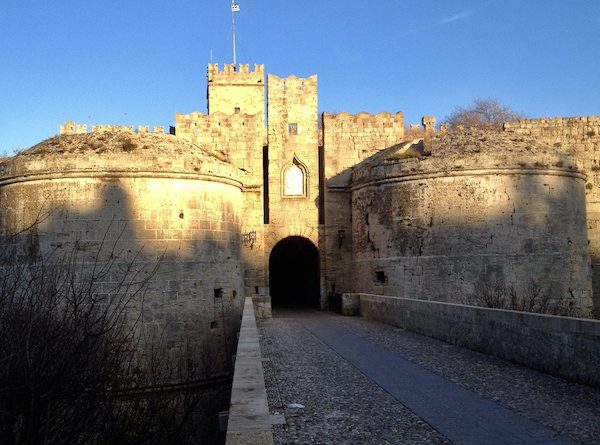
History Of Rhodes
History of Rhodes in Greece : in its long-lived existence, more than 2400 years of documented history, the island of Rhodes has always been at the center of the most important events that have affected humanity. Born independent, it managed to remain so for centuries, succumbing only to the dream of Alexander the Great and subsequently to the expansion of the Roman Empire. When the capital of the Roman Empire moved from Rome to Constantinople, Rhodes came under the hegemony of Byzantium.
Subsequently occupied by the Arabs, Venetians and Franks, under the dominion of the Knights of the Order of St. John (the Hospitallers) regained maritime and commercial importance. With the departure of the Knights of Rhodes , (later Knights of Malta), it was absorbed by the Ottoman Empire.
At the beginning of the twentieth century it was occupied by the Italian army and only with the end of World War II, together with the other islands of the Dodecanese, Rhodes finally became part of the Greek Republic . The History of Rhodes is rich in multiethnic influences, this island has always been a welcoming port in which to find traces of one’s origins with extreme ease.
History of Rhodes: the first traces
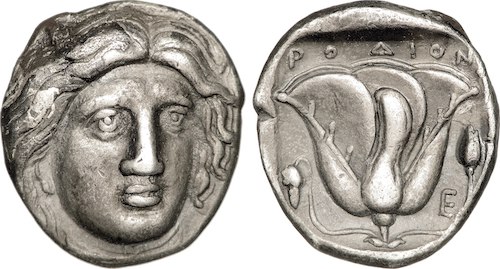
tetradrachm 316-305 AC History of Rhodes
History of Rhodes. The island of Rhodes had different names in ancient times: Ofiussa, Etrea, Macaria, Ataviria, Oloessa, Pelaghia, Piliessa, Stadia and Telchinia (following the occupation of the Telchini who are said to have come from Crete and were skilled blacksmiths) .
There are many legends that tell where the name Rhodes comes from, however the correlation with the rose has always prevailed, a flower sacred to Ilios , god of the sun . It was for this reason that the coins minted in Rhodes featured a rose on one face and the head of Ilios on the other.
Pindar narrates that Ilios and his wife, the nymph Rhoda, conceived seven children. Among these Cercfo who divided the island of Rhodes between his three sons: Ialisso , Kamiros and Lindos (the story instead attributes to the Dorians, around 1100 BC, the foundation of the three homonymous cities’ state).
The first traces of human activity, the History of Rhodes is dating back to the Neolithic period, have been found in different parts of the island while in the Copper Age Rhodes underwent the influence of the Minoans and Mycenians, as evidenced by several archaeological finds found in Ialisso and Trianda. Homer also mentions the three cities of Rhodes among those that sent ships during the Trojan War.
During the Archaic period, Ialissos , Kamiros and Lindos together with Halicarnassus, Cos and Cnidus formed a federation of six cities, the so-called Doric Hexapolis centered in the Sanctuary of Apollo on the Cnidus peninsula, and together they founded numerous colonies in Asia Minor and on the coast of the Mediterranean Sea (including Gela in Sicily ).
In the middle of the 5th century, Rhodes became a member of the Athenian League.
In 490 BC the Rhodesians were invaded by the Persians and, following the defeat of the latter, they became part of the Alliance of Delos (478 BC) and supported Athens’ effort to resist the threat of the Persians.
In these years, Diagoras, a member of the powerful Heraclid family, won the Olympics becoming one of the greatest Greek athletes. Being underestimated by the Athenians prompted the Rhodesians to leave the alliance in 411 BC during the Peloponnesian War.
History of Rhodes – The Foundation of the City of Rhodes
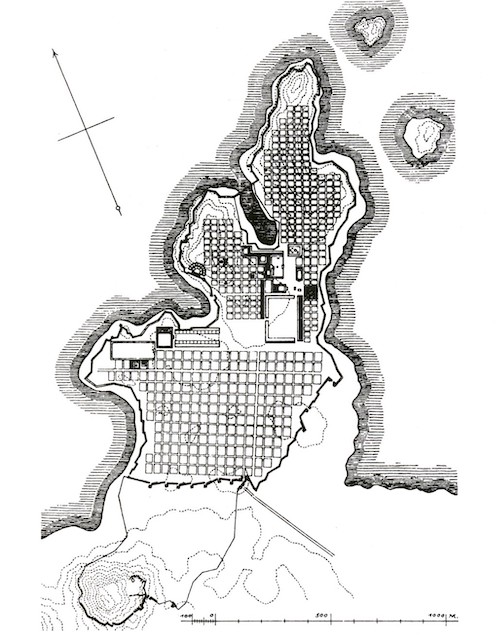
History of Rhodes. In 408 BC the three city-states of the island decided, on the initiative of the Olympian Dorieus of Ialysso , to found a new religious and commercial center which they called Rhodes and which was located in the northernmost point of the island, where even today is found.
The new city had, according to the plan of Hippodamus of Miletus, a circular plan and strong surrounding walls. The system adopted included parallel streets that intersecting perpendicularly created a rectangular grid adorned with temples, gymnasiums, theaters and other shining buildings. A wall, considered among the best defensive works of the time, protected the city from any enemy incursion.
At least five ports they welcomed ships from all over the world to their inlets, filling the city with merchandise and riches. The ancient urban network of the school of Hippodamus is still visible today in the current topography of the city, and extends both inside and outside the medieval walls of the City of the Knights (1480 AD).
The direction of the ancient streets has been preserved with slight variations during the Byzantine period, so that the Knights of the medieval city have inherited this urban system, together with a large part of the Byzantine building. In other words, we are faced with the rare case of using a road system that persisted continuously for almost 2400 years.
Archaeological excavations have brought to light classical monuments, such as: the Acropolis, the Temple of Apollo, the Stadium, the Odeion, the Neori, various temples and gymnasiums, sectors of the ancient fortifications, remains of houses, foundries, as well as networks. water and sewage systems.
The creation of the city was accompanied by an immediate splendor. It became a powerful economic center, guarantor of the freedom of the seas, and one of the main commercial centers of the eastern Mediterranean.
It printed its own currency, applied the first laws of maritime law and housed the famous Rhodes School of Rhetoric . The city was governed by its Parliament and by the Ecclesia, but for internal problems it remained under the Parliamentary control of the three cities that founded it.
The choice of its position and its natural advantages undoubtedly played their role in the rapid transformation of the city into an important economic and cultural center for the whole island.
The Hellenistic and Roman Period
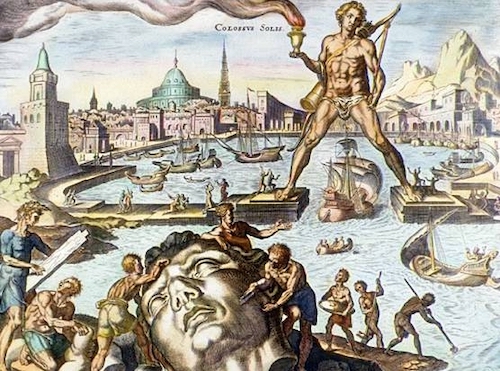
History of Rhodes. Maintaining in the orbit of Sparta until 396, the city of Rhodes later gave itself bodies of democratic government and in 394 it was on the side of Athens against Sparta; in 377 it took part in the second Naval League, but left it in 356.
Allied with the Persians, it took part in the defense of Tire besieged by Alexander and consequently in 332 it was occupied by a Macedonian garrison.
On Alexander’s death, the Macedonian garrison, Rhodes , was driven out it was considered the most powerful and the best governed of all the Hellenic cities, above all because it had better than all the Hellenes to free the sea from pirates.
He had close relations above all with Egypt, where most of his commercial currents were directed, but he had always known how to observe the most scrupulous neutrality towards the Diadochi (Alexander’s successors), until Antigonus, king of Syria, came to shock her with his crude pretensions.
Then took place his well-known defense against his son Demetrius the Poliorcete (which means conqueror of the city) who besieged the island for a year (305-4), but was eventually forced to retreat.
When he reviewed his forces, Rhodes realized that he had only 6000 citizens at his disposal, which for such an important city is surprising, and leads us to conclude that it possessed a very large number of slaves.
A thousand auxiliaries and mercenaries were added to that first nucleus as well as some valiant slaves freed by their masters, who were promised to grant citizenship. In order to increase the courage of the soldiers, solemn funeral honors were promised to them in the event of death and liberal support of their family members at public expense and thus a general harmony and emulation were established, for which the wealthy offered their wealth, the artisans their skills and their work, etc.
Even a mercenary leader showed the city all his loyalty by not allowing himself to be corrupted by Demetrius. On the other hand, the rabble in this Rhodian democracy did not have the upper hand, so much so that those who proposed to overthrow the statues of Antigonus and Demetrius received nothing but blame.
At the most dangerous moment, when the port threatened to fall into the hands of the enemy, the Pritani enlisted selected volunteers and embarked on three ships, which under a storm of darts accomplished the decisive enterprise, facing the siege engines of boats. Demetrius..
When then Ptolemy, Cassander and Lysimachus managed to supply the besieged with weapons and ammunition, and they repelled an enemy attack with a splendid defensive action, peace was finally reached. A previous mediation of Athens and other Hellenic cities had remained unsuccessful, but now Antigonus himself wanted his son to yield, and on the other hand Ptolemy gave the Rhodians the same advice.
These really had to make an alliance with Antigonus and hand over 100 hostages to him, but they placed the condition of never being forced to wage war against Ptolemy, they remained autonomous and without foreign garrison and kept their income.
After this peace, basically very favorable, Rhodes honored his warriors as he had promised, erected statues to Cassander and Lysimachus and, after consulting the oracle of Ammon, even consecrated to Ptolemy a “Temenos”, the so-called Ptolemy, as to a God.
Rhodes remained a moderate democracy with extensive trade and naval organization so perfect that Rome drew its maritime laws from her. It also became a famous artistic center that developed its own particular tendency to the grandiose and the colossal, as well as to brilliant effects: a Rhodian school of eloquence was formed, and the historians Zeno and Antisthenes wrote their stories, as Polybius says, not for personal gain, but for the sake of glory, and because it is well suited to politicians.
In memory of the victory of the Rhodesians against Demetrius, in 300 BC, a statue dedicated to the god Ilios was commissioned to Carete da Lindo, a pupil of Lysippos: the Colossus of Rhodes. It took 12 years of work to complete the 31 meters. of height of the bronze statue which, it is said, built with the proceeds of the sale of their war machines, it is said that it was placed astride the mouth of the port of Rhodes.
The statue apparently depicted a human figure at least 32 meters high, with legs apart at the entrance to the main port , resting on two marble bases, so that the ships passed under her legs; with a torch in his right hand, so as to also act as a lighthouse. Until then, the word Colossus indicated clay or wooden statuettes of human form and was used to indicate the statue of Rhodes , identifying since then with statues of enormous dimensions.
Thanks to the significant power acquired by the island, the Romans respected its autonomy and maintained an alliance with it. Damaged by an earthquake in 227 BC which also destroyed the Colossus , in 220 BC Rhodes was again at the head of an expedition against Byzantium, intent on taxing the goods that passed through the Bosphorus, and in 198 it was an ally of the Romans in the campaign against the ‘Euboea and against Philip V of Macedon.
The aid given back to Rome in 191-190 a. C. against Antioch earned her the donation of part of Lycia and Caria. But intimidated by the continuous expansion of Rome, Rhodes sought the alliance of Perseus of Macedon, but paid for the defeat of these (168 BC) the ruthless commercial competition that Rome moved with the foundation of the free port of Delos.
Only after giving proof of loyalty to Rome in the war against Mithridates, who siege it in vain, did Augustus give Rhodes the title of allied city: with Vespasian it finally became part of the Roman Empire and with Diocletian it became the capital. of the Insularum Province.
History of Rhodes – The Byzantine Period
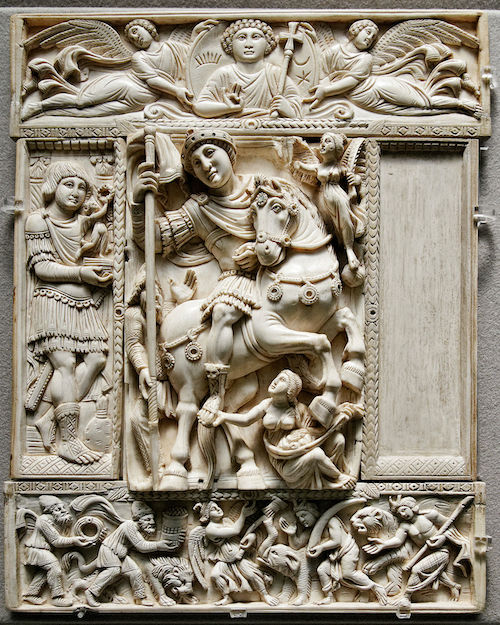
History of Rhodes. Visited by St. Paul in the sixth century. Christianity spread quickly on the island. In Lindos the first Christians were baptized. The bishops had the jurisprudence on twelve dioceses in the century. IX, they separated from the church of Rome and followed the schism of Photius.
The movement of the capital of the Empire from Rome to Constantinople, which took place in 330 AD, enhances the strategic and economic importance of the island. Positioned along the sea route that connects the imperial capital with the rich and fertile provinces of the empire such as Egypt, Syria and Palestine, it assumes an important role in Byzantine trade.
Recent excavations have brought to light magnificent public and private works of the fifth and sixth centuries AD, demonstrating a high technical and economic capacity. To worship God and to honor the martyrs of the new Christian religion, they built large basilicas in the city and in the countryside, decorated with frescoes, wall mosaics and multicolored marbles.
Divided the Empire,Rhodes was assigned to Byzantium and entrusted to the control of the governor Leon Gavalas who broke away from Constantinople. For the first centuries of the medieval period , Rhodes continues to be the capital of the island becoming the capital of the Ciberiotti when the Byzantines divided it into “temata” (provinces).
The end of the expansion arrives in 515 AD when a great earthquake razed it to the ground and despite the large sums of money given by the Emperor Anastasio, the city no longer regained its splendor.
At the beginning of the seventh century it was continuously attacked by the Persians at war with the Emperor Heraclius and was conquered in 620.
From 653 and for five years it was occupied by the Arabs of Syria and in 717/8 it passed to the Saracens. In 807 Caliph Harun al Rashid occupied and plundered the island for a short period and under the government of Emperor Alexis I it was attacked and occupied by pirates.
In 1097, occupied by the Crusaders, it became the bone of contention between Pisans, Genoese and Venetians who disputed its possession. During the fall of Constantinople at the hands of the Franks in 1204, the former governor of Rhodes Leone Gavala declared himself the crown prince (Caesar) alternating an independent position with one of alliance with Byzantium.
The Knights of St. John
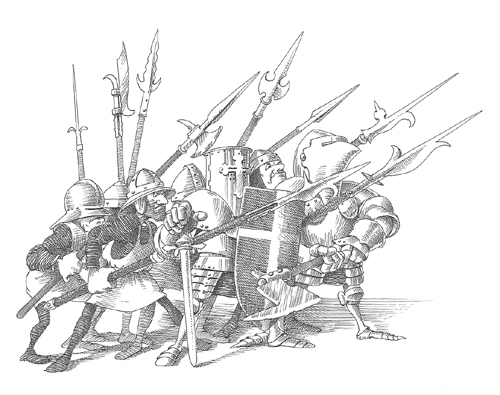
History of Rhodes. From 1261 Rhodes was theoretically part of the Empire of Byzantium but in reality it was governed by Genoese admirals who in 1306 by the admiral in charge Vignolo de Vignoli was sold to the Knights of St. John of Jerusalem who in 1310 took possession of Rhodes and , under the guidance of a Grand Master.
They reorganized the fleet and trade and received as a gift from Clement V part of the assets of the dissolved order of the Templars. The multinational composition of the chivalric order brings the island into contact with Western Europe both economically and politically but also culturally and they were an important page in the History of Rhodes.
Again, the port of Rhodes given its strategic position, it becomes a trading center for products from the East and the West. The resulting economic development leads to a rich social stratification with the upper classes of the nobles and the rich bourgeoisie.
The Greek element , after the middle of the fifteenth century, stands out particularly in the economic field. Thus a large group of Greek and Western scholars was formed who cultivated literature and the arts by studying Greek and Latin classics.
In the 213 years of the Knights ‘ domination , the port became one of the gates of Western Europe to the East, not only for material goods but also for ideas. The international composition of the Order of chivalry has as a consequence the repercussions on History of Rhodes , from every point of Europe, at least of the echo of new ideas on society, philosophy and art.
The Knights renovated and enlarged the city which at the end of the 15th century was considered one of the most beautiful and powerful in the eastern Mediterranean. The Palace of the Grand Master , a fortress built on the highest point of the city, was the seat of the central power of a unique state, whose possessions extended from the Iberian Peninsula to the Scandinavian countries, and from England to Cyprus.
Before the domination of the Knights , the place served as a last refuge for the defenders, first as an acropolis of Byzantine Rhodes and then probably as the seat and residence of the Byzantine governor of the island. The invasion by the Turks of the Aegean area led them to conflict with the Knights of San Giovanni in 1480.
The first siege ended with the defeat of the Turks and the reorganization of the defense of the city .
In 1522, however, the Turkish Sultan Suleiman I, winner of Belgrade, attacked the island with 100,000 men. The Venetians, the Genoese and the inhabitants of Candia came to the aid of the Knights , but after 6 months, on 1 January 1523, Villers de l’Isle-Adam left the island with the 180 remaining Knights, and they closed this chapter in the History of Rhodes.
Due to the resistance that the island opposed, Suleiman the Magnificent excluded Rhodes from the privileged regime that he had instead guaranteed to the other islands that had not resisted him. At the same time he expelled all the Greek-Christian population from the island while most of the churches were converted into mosques.
To enable Rhodes to continue to play the same economic role that he had played in the area before the Ottoman conquest, Suleiman brought the Spanish Sefardim Jews into the city to support the Jewish elements already existing and to which particular privileges were guaranteed such as that of settling in a neighborhood within the walls called Ouriki, the right to practice their religion continuously and 120 years of favorable tax treatment.
The progress of the Jewish community in Rhodes and the spiritual presence and activity of the Rabbi led the island to be converted into a small Jerusalem.
During the period of the Ottoman rule Rhodes it was the center of the whole area and the capital of the Ottoman administrative unit, which also included other islands. Despite this, the events did not allow Rhodes to become the new center of the international market.
History of Rhodes – Italian occupation
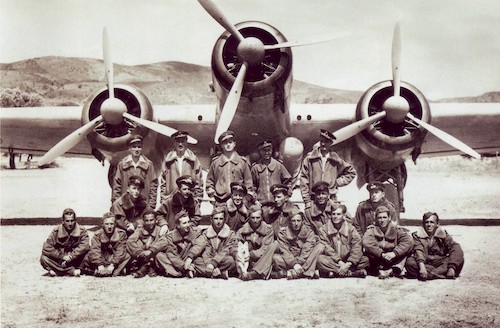
History of Rhodes. The Dodecanese campaign was nothing more than the logical extension of the conflict that broke out between Italy and Turkey following the occupation by the former of Libya, the last region of Northern Africa still subject to the sovereignty of the Sacred Door.
Following the landing in Libya and the unexpected difficulties encountered by the Italian Expeditionary Corps in conquering the key points of Tripolitania and Cyrenaica (the reaction of the Libyan tribes, armed and flanked by a large number of Turkish military advisors made the consolidation and the penetration of the columns inside the territory).
The Italian Supreme Command was pushed to carry out, through the contribution of the Navy, a series of operations against the Ottoman forces along the coasts of Lebanon, in the Red Sea and in the northern Aegean. At the end of March 1912 Vittorio Emanuele III and the military leaders started a series of naval operations and landing in the Aegean.
Maneuvers whose primary purpose was to force the Sacra Porta to stop the resistance in Libya and to gladly accept its stable occupation by Italy. In fact, according to the plans of Rome, the conquest of the southern Sporades would have assumed a “temporary” character, as it was thought to return the islands to the Ottoman Empire when all resistance in Libya had ceased.
The contingent, which amounted to about 9,000 officers and soldiers, was placed under the command of Lieutenant General Giovanni Battista Ameglio. The naval team, which would have been responsible for transporting and escorting the Expeditionary Corps from Libya to Rhodes , was instead entrusted to Vice Admiral Marcello Amero d’Aste Stella.
As planned, at dawn on May 4, 1912, Amero’s team arrived completely undisturbed in front of Kalithea . Before proceeding to disembark the bulk of the troops, the admiral, in agreement with General Ameglio, sent a group of armed sailors ashore. Once on the beach, the handpiece carried out an accurate reconnaissance of the area and, after a couple of hours, not having found the presence of any enemy unit, signaled the go-ahead to the flagship.
In a short time, the entire Expeditionary Force landed. At the head of his troops, General Ameglio moved north. Towards evening, on the Koskino hill and in the locality of Asguru, the march of the avant-garde on horseback from Ameglio was opposed with very little conviction by an Ottoman unit made up of about 400 men.
Having easily beaten the Turks, the Italian columns resumed their march in the direction of the Psinthos redoubt, where, according to reports received by Ameglio, the enemy was concentrating all his forces. In the meantime, the Alpine destroyer (commander Gustavo Nicastro) headed to the city of Rhodes to order the surrender to vali (Turkish governor). The latter, after taking time to decide, fled with a small boat to Lindos , a small port located on the west Anatolian coast where, on May 28th, he will be captured by the sailors of the Ostro fighter.
On the morning of May 5, Admiral Leone Viale sent Rear Admiral Camillo Corsi (his Chief of Staff) ashore with the task of taking possession of the town of Rhodes that, in the meantime, had been reached by the avant-garde of General Ameglio and, at 2 pm of the same day, a picket raised the tricolor on the old Turkish castle placed to defend the mouth of the port.
With the conquest of the island by the Italians, the urban landscape of Rhodes was significantly changed. Examples of this architecture are the Albergo delle Rose, by the architect Platania and, among other modern buildings surrounding the port of Mandraki , the Government Palace, the work of 1927 by Di Fausto, famous for the antelopes that adorn the columns. of the mouthpiece.
Numerous restorations were also undertaken, which often expired in a pseudo medieval style, as in the case of the Great Master Palace, from the 14th century, destroyed by an explosion in 1856. In order to serve as a residence for King Vittorio Emanuele III and Mussolini, it was completely rebuilt, decorating it with mosaics and other materials from buildings on the nearby islands, in a rather pompous style , to the detriment of historical rigor.
A similar situation is that of the cathedral of The knights of Saint John , from the 14th century, but rebuilt in 1926 according to the design of the convent church which until 1856 was located in one of the ends of the street of the Knights.
In the interior decoration stand out the reproductions of San Giovanni di Donatello and fourteen stone sculptures of the Via Crucis, the work of Maraini. However, neither oriental architecture nor these contemporary works have managed to prevail over the principles and ideals of the Hospitaller Order which have left their unmistakable imprint on the whole city , both in the numerous palaces and in the charitable institutions.
In 1988 the old town of Rhodes was recognized by Unesco as a World Heritage Site. Rhodes , like the other islands of the Dodecanese, was finally included in the borders of the Greek republic, born after the insurrection of 1821, in 1948 at the end of the Second World War.
History of Rhodes
